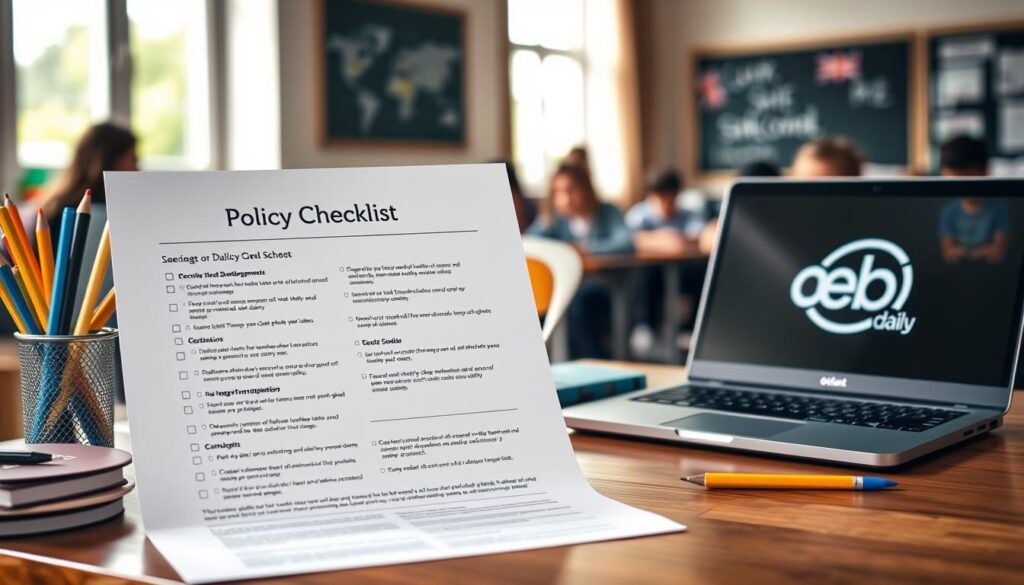5 Key Updates in Keeping Children Safe in Education 2024 (UK Edition)
Keeping Children Safe in Education 2024 outlines the major policy updates introduced by the UK Department for Education, helping schools and colleges strengthen safeguarding and staff training practices.
One in ten schools reported a major policy update after the statutory guidance was revised, underlining the scale of change leaders must grasp.
The guide sets the scene for leaders and DSLs in England. It explains who should read Part One and how the document underpins legal duties to keep every pupil protected.
These safeguarding frameworks are closely connected to modern education ecosystems like Education City, which integrate technology, innovation and safety within UK campuses.
This introduction summarises five headline updates: wording on abuse, a greater emphasis on early help and attendance, cautious gender-questioning advice, duties for alternative provision, and clearer digital safety and data rules.
The 2024 version largely refines wording rather than overhauls process, while the next version signals technical edits and potential future shifts linked to wider inquiries and legislation.
This Ultimate Guide focuses on digital safety (filtering, monitoring and UK GDPR), staff training, and policy alignment so schools can act efficiently and sustain a strong safeguarding culture.
Key Takeaways
- Statutory guidance applies to England and sets legal duties for schools and colleges.
- All staff should read Part One to understand core responsibilities.
- Five headline updates simplify terminology and sharpen early help and attendance focus.
- Digital safety and UK GDPR compliance are top priorities for policy revision.
- The guide allows proportionate, practical adjustments without disrupting core practice.
Why this Ultimate Guide matters for UK schools and colleges
Understanding the revised guidance helps leaders focus effort where it truly reduces risk and improves practice.
The Department for Education is clear: every member of staff should read Part One to grasp baseline duties. This version highlights digital safety, timely training and tightened compliance steps that leaders must prioritise first.
- Prioritise policies: leaders should align wording so governance and staff share the same understanding of protection and early help.
- Target effort: concentrate on digital controls, routine safeguarding practice and accurate record-keeping to reduce the biggest risks.
- Prepare staff: reading Part One gives staff baseline knowledge while leaders and DSLs translate requirements into clear actions across settings.
Precise wording changes affect inspection evidence and operational readiness. Taking a structured approach now makes future version transitions quicker and less disruptive, and it delivers more consistent responses for children through better attendance conversations and safer online environments.
What stayed the same in KCSIE 2024
Many operational routines stay the same, which helps schools focus on new priorities rather than full policy rewrites.
Key statutory parts retained their wording. Part Three on safer recruitment was left unchanged. Existing selection, vetting and single central record practices continue to be the benchmark.
Where continuity matters
Part Four remains stable. Allegations and low‑level concerns keep the same reporting lines, thresholds and governance steps. Schools can keep current flowcharts and staff briefings with routine checks.
Part Five only adjusted paragraph 497 to mirror updated Working Together wording. That tweak keeps the response to child‑on‑child incidents aligned with early help principles without shifting core practice.
- Maintain routine quality assurance for recruitment files and the single central record.
- Keep refresher scenarios so staff spot and report concerns quickly.
- Audit Parts Three to Five to verify documentation and staff confidence.
The 2024 updates are mostly textual edits rather than radical changes. DSLs and administrators can therefore target effort to the sections that did change, while preserving strong, established systems for allegations, recruitment and escalation.
The five most important changes schools must action from keeping children safe in education 2024
This part summarises five practical updates that schools must implement without delay. Each change adjusts wording or duties that affect policy, training and daily practice.
1. Abuse, neglect and exploitation — wording and practice
The phrase “abuse and neglect” is now “abuse, neglect and exploitation” across Parts One and Two (see paragraphs 19, 66, 202 and Annex A). Schools should update policy headings and staff slides so exploitation risks — criminal and sexual exploitation — are explicit.
2. Early help and attendance language
Early help now highlights multiple suspensions and risk of permanent exclusion (paragraph 18). Absence wording changes from “deliberately missing education” to “unexplainable and/or persistent absences”.
Pastoral teams must revise attendance scripts and referral prompts to trigger timely multi‑agency conversations.
3. Guidance on LGB or gender questioning pupils
Paragraphs 205–209 set a cautious, case‑by‑case approach for pupils who are LGB or gender questioning. Staff should consider the full range of needs and involve parents unless this would create significant risk of harm.
4. Alternative provision duty
New paragraph 171 clarifies that when a school places a pupil with an alternative provision, the school remains responsible for safeguarding. Leaders must evidence due diligence that the provider meets the pupil’s needs and has robust arrangements.
5. Domestic abuse wording and practical steps
Domestic abuse now explicitly notes when a pupil may see, hear or experience its effects. This strengthens assessment prompts and early help planning.
Immediate admin tasks: update policy language, tweak DSL templates, amend induction slides and add training scenarios that integrate exploitation risks, persistent absence casework and sensitive parental engagement for gender questioning cases.
- Governors: sample AP placement files and request assurance on how new language is embedded daily.
- Training: include digital safety and staff competency checks alongside the new wording to ensure consistent practice.
Digital safety and data protection: filtering, monitoring, and compliant information handling

Digital controls and data routines are now central to daily safeguarding tasks across classrooms and networks.
Schools must join technical management with clear human decisions. That means naming who decides on filters, who monitors logs, and how staff escalate worries. Clear roles reduce delay and show inspectors that governance is active.
Clarifying roles for filtering and monitoring
Responsibilities should state who approves filter changes, who reviews alerts, and how referrals reach the DSL. Regular checks ensure controls work for both curriculum use and child protection.
Using DfE data protection guidance to meet UK GDPR duties
Paragraph 93 directs schools to the department education data protection guidance. Schools should map data flows, minimise collection and keep retention schedules. A DPIA is recommended for any platform that processes pupil information.
Documenting DSL decisions and rationales
DSLs must record discussions and rationales (see Annex C). Notes should explain why a referral was or was not made, consent steps, and professional judgement used.
“Documented decisions provide a clear audit trail that links technical evidence to safeguarding choices.”
Practical artefacts include a filtering policy, an asset register, scheduled checks, and a termly report to governors. Staff micro-briefings should cover online harms and lawful handling of digital evidence.
| Area | Who | Action | Evidence |
|---|---|---|---|
| Filtering policy | Head/IT lead | Approve and review termly | Signed policy, review log |
| Monitoring alerts | Designated monitor/DSL | Investigate and escalate within 24 hrs | Incident log, timestamps |
| Data protection | DPO / SLT | Map flows, run DPIA for new platforms | DPIA documents, retention schedule |
| Access controls | IT manager | Test role permissions termly | Access audit, test records |
- Align incident playbooks so IT, safeguarding and data protection responses are coordinated.
- Ensure only authorised adults access sensitive records and follow subject access request processes.
- Report termly to governors with anonymised trends and improvements.
Staff training: updating knowledge, delivery methods, and measuring outcomes
Training should bridge policy language and frontline practice, so staff act with confidence. This section sets out the essential updates, modern delivery options and simple ways to test competence.
What staff need to know now
Priority content must include the revised terminology “abuse, neglect and exploitation”, triggers for early help such as multiple suspensions and persistent absence, and recognition when a pupil sees, hears or experiences domestic abuse.
Flexible training delivery
Blend formats to suit busy timetables: workshops for depth, micro-learning for rapid refreshers, short videos and audio briefings for on-the-go access. Scenario practice should cover attendance conversations, gender-questioning cases and alternative provision oversight.
Assessing knowledge, not attendance
Leaders should measure outcomes through quizzes, case reviews and brief assessments mapped to safeguarding competencies. Keep an evidence pack of plans, materials, results and actions taken where gaps appear.
“Assess knowledge and decision-making, not just presence at a session.”
- Include Part One essentials in induction and timely refreshers.
- Use monthly five-minute micro-lessons and end-of-term pulse checks to save time.
- Ensure one-click reporting and easy access to key guidance and thresholds.
Policy and compliance checklist for schools, colleges, and DSLs

This checklist gives governors, leaders and DSLs a practical route for updating policies and showing compliance.
Core wording and statutory alignment
Update all child protection and safeguarding policies to use the phrase “abuse, neglect and exploitation” across annexes, staff guides and induction packs.
Data protection and statutory references
Signpost DfE data protection guidance (paragraph 93) and add a brief summary of UK GDPR and DPA duties for record handling and retention.
Alternative provision and domestic abuse
Include the AP clause from paragraph 171, stating the school retains safeguarding responsibility and must evidence due diligence.
Add domestic abuse wording that notes when a pupil may see, hear or experience its effects so staff can recognise and record risks accurately.
DSL recording and governance checks
Require DSLs to record decisions and rationales per Annex C, including when referrals are not made.
- Termly policy review and sample case file audits.
- AP provider assurance checks and management oversight routes for reported concerns.
- Clear signposts to further guidance and named responsibilities for senior leaders.
Keep policy language concise and practical: state routes for action, responsibilities and where staff find key information quickly.
Timeline and what’s next: preparing for September and the 2025 version
Start with a small action log and termly checkpoints to make future technical edits straightforward. A modest readiness plan reduces pressure and preserves leadership time.
Plan now for september 2025. Embed the September 2024 wording across policy, training and AP checks today. Schedule a mid‑year review and keep an evidence pack that shows decisions, dates and outcomes.
Planning ahead amid technical 2025 updates and emerging national learnings
Track official announcements from the department education so the senior team can act quickly when the next version is published.
Governors should set termly policy checkpoints and confirm AP due diligence. Use a simple dashboard to record progress on staff competency, filtering, monitoring and access controls.
- Maintain a live action log and evidence pack for audits.
- Test business continuity each term: platform access, backups and escalation routes.
- Coordinate updates centrally for multi‑site settings, with local addenda where needed.
“A short readiness dashboard helps leaders brief stakeholders and keep momentum as national findings and technical changes arrive.”
Conclusion
, This final paragraph pulls the key obligations together so leaders can act with clarity and pace.
Adopt the revised wording—notably “abuse, neglect and exploitation”—and reinforce early‑help prompts, cautious handling of gender‑questioning cases, and AP due diligence. DSLs must record rationales clearly to create a defensible information trail.
Prioritise digital safety: name who manages filtering and monitoring, follow DfE data guidance and audit access controls. Pair policy updates with a pragmatic training plan that measures knowledge, not just attendance.
Finish wording changes, brief staff, test workflows and run a short data and records audit. These modest updates sharpen safeguarding practice and support keeping children safe as the next version arrives.
Finish wording changes, brief staff, test workflows and run a short data and records audit. These modest updates sharpen safeguarding practice and support keeping children safe as the next version arrives. For full statutory guidance and downloadable resources, visit the UK Government Department for Education.



